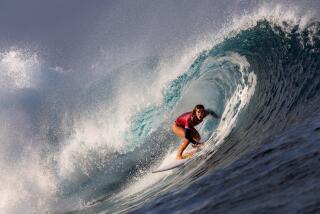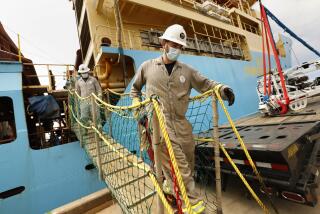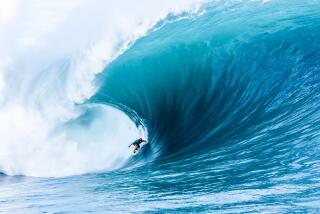Fresh Angle : Ultra-light Equipment and Artificial Lures Make Surf Fishing Accessible, Inexpensive
- Share via
Surf fishing used to be as exciting as ice fishing but without the possibility of being saved from boredom by hypothermia.
Immobilized by heavy equipment, a surf fisherman was forced to be a stationary life form. Parking himself on a beach chair after casting into the surf, he would deposit his 15-foot monster rod into a sand spike and wait . . . and wait . . . for a fish to chance upon the baited hook.
In the past few years, however, more and more surf fishermen have evolved into Bedouins of the beach. Gone is the seven-pound rod and reel, trunk-size tackle box, beach chair and cooler--replaced by ultra-light tackle for a sleeker look and greater mobility.
There still are surf fisherman who just like to hang out at the beach, preferring to catch sun rays instead of 60-pound bat rays, but “most everybody’s into ultra-light rods and reels,” said Eric Hoff, manager of a tackle shop in Ventura. He added: “Not many people use the long rods any more.”
Traveling light makes sense, Charlie Price said. “It’s nonsense to take everything you own with you,” said Price, 61, an investment consultant who lives in Ventura.
Hoff credits Price, who used to work part time in tackle shops, and longtime tackle-shop owners Bob Johns of Oxnard and Bob Wylies of Malibu with helping to popularize ultra-light surf fishing in Ventura County. Hoff estimated that Price has introduced what is essentially freshwater gear to hundreds of surf fishermen. And he also has introduced surf fishermen to artificial lures, which eliminate the need to transport bulky containers of fresh bait--such as mussels and squid--to the beach.
The combination--inexpensive ultra-light equipment and artificial lures--has made surf fishing more accessible and mainstream, experts say. “A lot of people who can’t afford to go on a boat for game fish are surf fishing,” Hoff said.
Price compares the modern surf fishermen to stream fishermen who walk long distances along the bank searching for a hot spot. “I consider the surf a long, slow stream,” Price said. “You move from spot to spot, looking for fish. You don’t expect the fish to go and find your bait. Sitting in a chair has got to be one of the poorer ways to fish.”
Price is the quintessential beach Bedouin. He rides his bike to the ocean, an 8 1/2-foot ultra-light rod strapped to the crossbeam. Setting his bike down on the beach--”nobody can ride off with it on the sand,” he said--Price wanders up and down the shoreline for a few hundred yards in both directions. Together, his rod and reel weigh less than a pound. He carries lures and other items in a box no larger than a thick paperback. Keeping only enough fish to eat, he cleans his catch at the beach.
When Price was 14, at the end of World War II, he fished for steelhead at the mouth of both the Ventura and Santa Clara rivers, using a cane pole and artificial lures. To his surprise, he also caught barred surfperch, a strictly saltwater fish, and discovered that ocean inhabitants don’t discriminate between freshwater and saltwater equipment. He has used artificial lures, even flies, ever since, catching everything from halibut to thresher shark.
“I catch five times as many fish with lures (than live bait),” said Price, who either makes his own lures or modifies the commercial variety. The current commercial fish-killer, he says, is the motor-oil grub, but Price also has success with a four-inch artificial anchovy that he modified by adding a posterior barb and doll eyes, which he attached with super glue.
The most popular prey for surf fisherman, Price says, are barred surfperch, a year-round fish that is spawning now; gray California corvina, best caught in the fall; yellow-fin croaker, catchable year-round, and halibut, which also can be caught all year but especially when the grunion are running. Occasionally, Price will hook a California white sea bass and stripped mullets and also has found shovel-nose guitarfish and bat rays at the end of his six-pound-test line.
“I snagged a bat ray that must have weighed 50 or 60 pounds,” he said. “It felt like a VW. Must have pulled me a half-mile down the beach.”
This is expected to be a good year for corvina because El Nino conditions are warming Southern California waters farther north than usual. Hoff calls the corvina, which can weigh as much as 10 pounds, “the swordfish of the surf.” Price, whose hobby is studying fish, said he often has seen schools of 30 or 40 corvina in one area off the Ventura coast.
“They’ll get sideways to the ocean currents and let the waves take them in toward shore to find the sand crabs,” he said.
A few years ago, Price paddled his longboard beyond the surf line to fish for rare Pacific bonito, but surf fishermen don’t really have to go to such extremes. Walking knee-deep into the surf is about as wet as you need to get--a cast from the beach often will be adequate.
“Fifty yards covers most of the water you want to cast,” he said. “Those long rods throw out too far. They go over 90% of the fish.”
Like all fishing, surf fishing requires more than luck. Along with an annual license, a surf fisherman must have knowledge of tides--generally, the best time to fish is when the tides are moving in or out--and also must learn as much as possible about the fish and their habits, but most importantly, a surf fisherman has to “read the water,” Price said.
Most fish congregate in holes that have been gouged out of the ocean floor by large waves. By observing the action of the surf, it’s possible to locate a hole: Breaking waves will flatten out over a hole, defining an area that could be half as big as a football field.
Holes can usually be found on the windward side of jetties, at the mouths of rivers and by the outflow of a power plant. Price suggested that “a learner should observe the beach at low tide to see holes a lot easier.”
Other factors Price considers important are clear water, a relatively small surf and little wind. But regardless of the conditions, he just likes to be out surf fishing.
“Solitude is not the same as loneliness,” he said. “On the beach, you have solitude. You’re at one with nature. You’re out there with just your basic gear and the elements. That’s the reward you get for surf fishing.”
More to Read
Sign up for Essential California
The most important California stories and recommendations in your inbox every morning.
You may occasionally receive promotional content from the Los Angeles Times.










